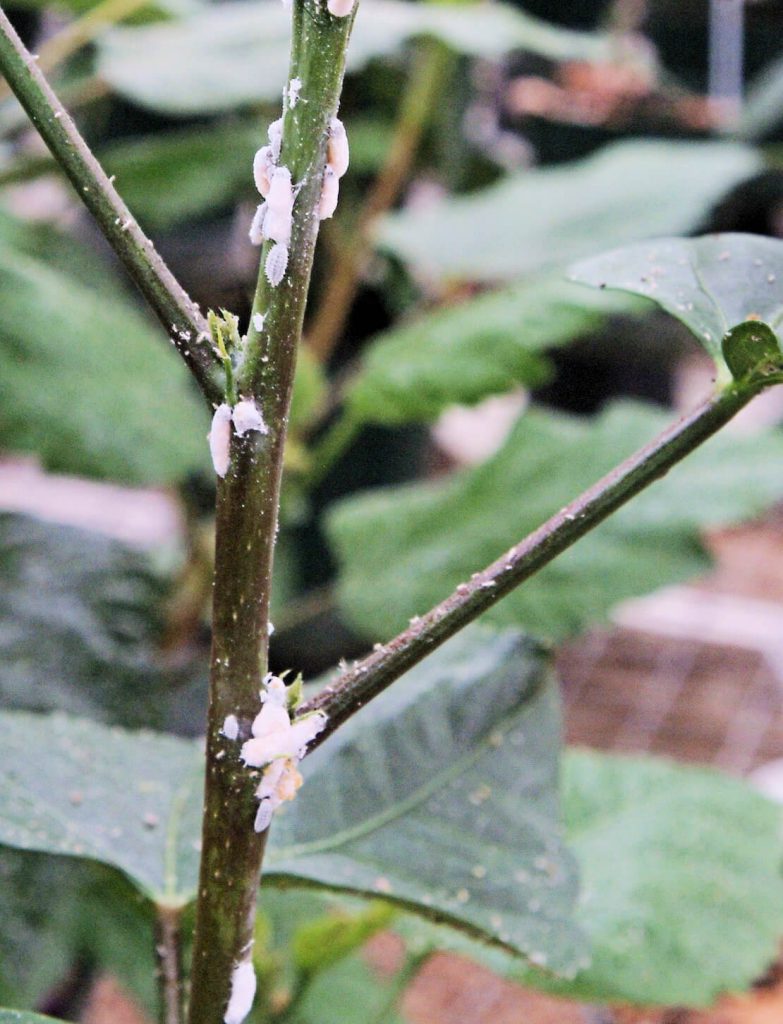
They creep in slowly with their unassuming soft-bodied nature settling in on plants like a meeting of tiny, friendly jelly donuts. Unbeknownst to the gardener, these insects, known as mealybugs, have inserted their mouthparts into the plant literally sucking the lifeblood out. As more mealybugs accumulate, the plant begins to suffer and decline. What can we do to curb the scourge of this powdery pest?
There are a great number of mealybug species in Florida with colorful, tropical fruit salad-like names such as “pink hibiscus”, “pineapple”, “citrus”, “papaya”, and “coconut”. While these names may give some clue as to their favored host plants, in general mealybugs feed on a great number of ornamentals and fruits. Mealybugs begin life as a tiny nymph called a “crawler”. At this stage, the crawler moves around and is so tiny as to be easily transported unseen from place to place. Weeks later, the young mealybug settles down and plunges its mouthparts into the plant for a long drink. The males look very different and actually develop wings. Males have no mouthparts as adults and are designed just to breed and die. Stationary for the most part in plant nooks and crannies,(including roots), mealybugs are mature in about ten weeks. They cover themselves with white waxy coatings and filaments for protection from outside threats. Females can lay up to six-hundred eggs in a cotton-like protective covering.
So, mealybugs are a fact-of-life for home gardeners and the plants they love. In addition to the actual loss of plant fluids, mealybugs inject chemicals that cause damage to plants in the form of distortion, stunting and yellowing. They also secrete a great deal of honeydew, a sugary waste product on which benign sooty mold grows. Ants are collaborators here as they use the honeydew as food and actually protect and “farm” mealybugs like livestock.
You may have accidently brought mealybugs into your yard on a new plant. Inspect plants carefully and/or quarantine any new introductions to your landscape – prevention is worth a pound of cure! Infestations will appear as cottony white patches which, upon careful observation, will show several individuals clustered together. Depending on the plant, use either insecticidal soap or horticultural oil applied as per label directions (not used in the heat of the day as it can burn the leaves) to spot treat infestations as discovered. There are also plenty of natural predators and parasites attracted to mealybugs, so let them do their work. Locally, “mealybug destroyers” , a type of ladybeetle larva, do a fair job of controlling mealybugs. Bottom-line – monitor often and spot treat small infestations before they get out of hand. Heavily infested plants may need to be disposed entirely.
Mealybugs are cottony insidious creatures bent on world domination. Properly identify them, review your control options and make your move! For more information on all types of landscape pest control suggestions, or to ask a question, please visit https://www.facebook.com/CharlotteMGLifeline/. Ralph E. Mitchell is the Director/Horticulture Agent for the UF/IFAS Charlotte County Extension Service. He can be reached at 941-764-4344 or ralph.mitchell@charlottecountyfl.gov.
Don’t forget that Florida-Friendly Landscaping™ is a program that our office encourages as it promotes planting the “right plant in the right place”, water conservation, common sense pest management, sensible use of fertilizers, composting, etc. that help develop a sustainable landscape. For more information on this important, over-arching program, please contact Sara Weber, FFL Education-Training Specialist, at Sara.Weber@charlottecountyfl.gov .
Resources:
McCormick, K. (2019) Questions From The Plant Clinic: Mealybugs. The University of Florida Extension Service, IFAS – Seminole Country
Byron, M. A. & Gillett-Kaufman, J. L. (2019) longtailed mealybug. The University of Florida Extension Service, IFAS – Featured Creatures
 0
0
